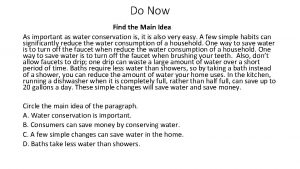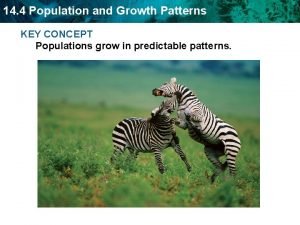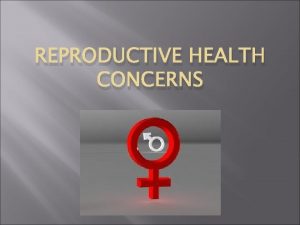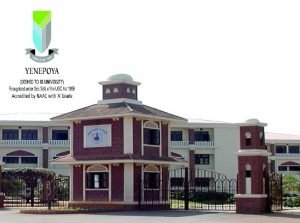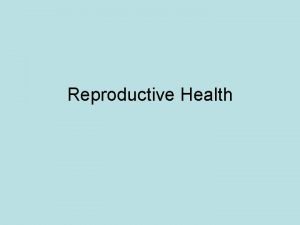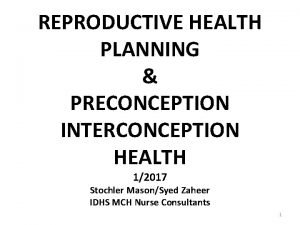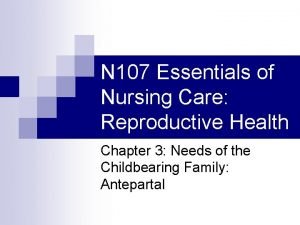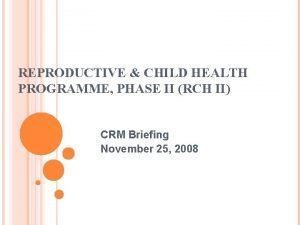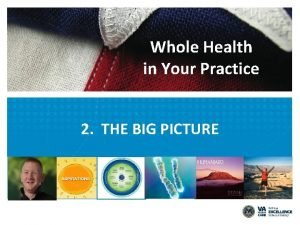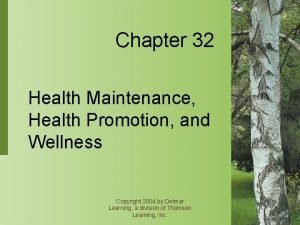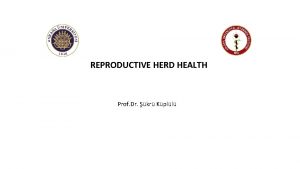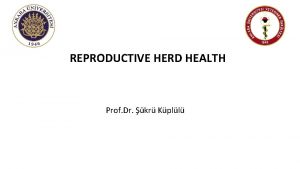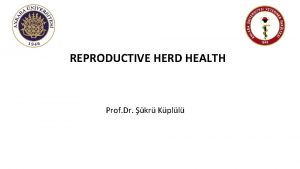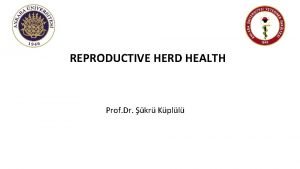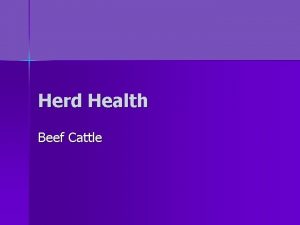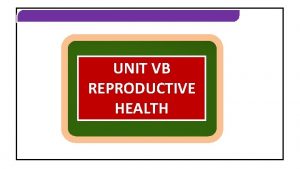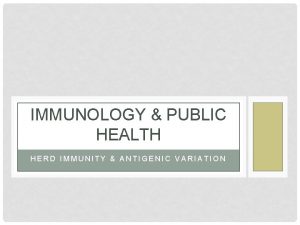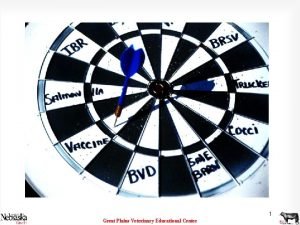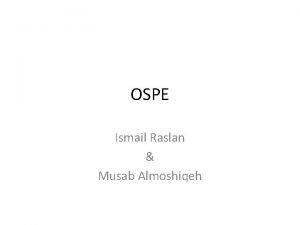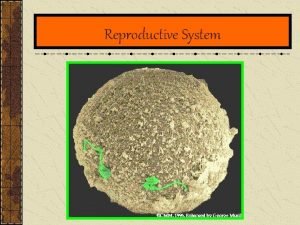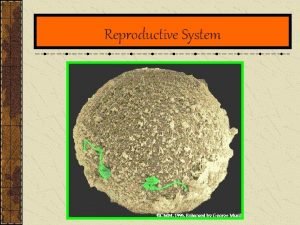REPRODUCTIVE HERD HEALTH Prof Dr kr Kpll CLINICALPRACTICAL














![Metritis is sometimes a CONCLUSION and sometimes a CAUSES [Infertility] Metritis is an immunological Metritis is sometimes a CONCLUSION and sometimes a CAUSES [Infertility] Metritis is an immunological](https://slidetodoc.com/presentation_image_h/c2d9705671d5db53ba6f989bd818ca02/image-15.jpg)







- Slides: 22

REPRODUCTIVE HERD HEALTH Prof. Dr. Şükrü Küplülü

CLINICAL-PRACTICAL APPROACH TO UTERUS INFECTIONS IN COWS

Hypothetical Approach to Fertility 1 year 365 days P R E G 280 day Doğum P O S T P A R T U M • involution • Endometrial regeneration • Start of cyclic activity • Purification of infections Insemination (3 seeding chance) Conception 43 86 43 0

Postpartum uterine infections (Hansen, 2013)

Postpartum uterine contamination (Sheldon ve Dobson, 2004)

The most common bacterial species and density in P. P uterus □ Trueperella pyogenes, ■ E. coli (Williams, 2013).

P. P. Factors Associated with the Development of Uterine Infections (Noakes, 2009)

The face of metritis (the importance of the Puerperal period) Lochia (Küplülü Ş, Vural R, Polat M , 2012)

The face of metritis (the importance of the Puerperal period) (Küplülü Ş, Vural R, Polat M , 2012)

Puerperal physiology-pathology (Küplülü Ş, Vural R, Polat M , 2012)

Puerperal physiology-pathology (Küplülü Ş, Vural R, Polat M , 2012)

Puerperal physiology-pathology (Stella ve ark. , 2016)

Economic importance of metritis Metritis are, * Seen on every cow and farm NEGATIVE RESULTS OF METRITIS Death Treatment costs Labor Milk loss Meat-milk antibiotic residual problem Infertility Sterility - Cutting ECONOMIC LOSS

Incidence of Metritis - Factors affecting incidence Variable - increases or multiplies depending on factors. Every farm Metritis incidence rates Postpartum metritis: 36 -50% (40%) Systemic symptoms: 15 -20% (3 weeks postpartum) Subclinical endometritis: 30% Herd management and management Vaccination program Feeding in transition period Negative energy balance Management of birth process Mat, birth aid, etc. Immunological competence of flock and individual Stres Intensity of the causative agents of infection Environmental hygiene Sheldon, 2009
![Metritis is sometimes a CONCLUSION and sometimes a CAUSES Infertility Metritis is an immunological Metritis is sometimes a CONCLUSION and sometimes a CAUSES [Infertility] Metritis is an immunological](https://slidetodoc.com/presentation_image_h/c2d9705671d5db53ba6f989bd818ca02/image-15.jpg)
Metritis is sometimes a CONCLUSION and sometimes a CAUSES [Infertility] Metritis is an immunological problem Sudden increase in metabolic requirement Fry growth and milk synthesis Risk factors Transition period dry matter intake (Risk factors are effective) NEB (IGF-I, insulin) Affects cellular immunity PMN weakness METRİTİS Mikroorganism

Transition immunology and uterine infections NEGATIVE ENERGY CURVE BEFORE AND AFTER BIRTH Parturition Increased Energy Demand • Rapid growth of the calf • Kolostrogenezis Disadvantage KM uptake reduction High steroid cortisol Energy curve and balance Increased Energy Demand • High lactation • Insulin independent energy use of the udder Disadvantage Ruminal adaptation Metritis low Metritis more NEB = NEFA = IGF-I = PMN reduction = Ig production reduction = Immune deficiency

Water intake-Metritis relationship in periparturient period J. M. Huzzey and T. R. Overton, Cornell University

The relationship between dry matter intake and metritis in the periparturient period J. M. Huzzey and T. R. Overton, Cornell University

Metritis, factor-predisposition factors and the role of immunity FACTORS bacteria E. Coli a. pyogenes I f. necroph Streptococcus spp. Staphylococcus spp. viruses IBR (Herpes 1 and 4) BVD-MD Mushrooms Aspergillus fumigatus Mucor spp. Mortierella wolfii parasites Neospora species. Tritrichomonas Sarcocystis neuroni Parazitler FACTOR / RISK LEVEL Retentio sec. Power birth Abortions Stillbirth twins hypocalcemia Metabolic diseases Season IMPROVEMENT or metritis IMMUNOLOGICAL FACTORS 1. Cellular immunity (Leukocytes) 2. Humoral immunity 3. Complement proteins 4. Mechanical defense (involution, mucosal health, mucus) IMMUNOLOGICAL AND RISK FACTORS INTERACTION TARGET Less active agent to the uterus / Predisposition factors should be monitored / Active immune system

How important are the risk factors in metritis? (How do they impact) A. pyogenes G. Opsomer, A. de Kruif, 2009

Uterine Infections-Ovarium Function Interactions E. coli şemotaksis Sheldon et al. , 2009

Metritis-Fertility: Prognosis 1. Type of infection 2. The duration of infection in the uterus 3. Endometrial gland degeneration 4. Depends on the effectiveness of treatment Cervisitis Oophoritis Salphingitis IBR, BVD Neospora Heat stress Mineral Trace element Vitamin ? Sperm factor Seeding factor Insemination at the right time
 Highlight or underline key ideas in each passage
Highlight or underline key ideas in each passage A day with nandu lesson plan
A day with nandu lesson plan Herd
Herd Herd learning
Herd learning Acnc governance standard 3
Acnc governance standard 3 What is the movement of a single caribou into a herd
What is the movement of a single caribou into a herd Inguinal
Inguinal Rch programme
Rch programme Reproductive health definition
Reproductive health definition Interconception definition
Interconception definition Role of nurse in reproductive health ppt
Role of nurse in reproductive health ppt Rch 2 programme
Rch 2 programme Role and responsibility of occupational health nurse
Role and responsibility of occupational health nurse National health intervention programme for mother and child
National health intervention programme for mother and child Health standards louisiana
Health standards louisiana Differentiate between health education and health promotion
Differentiate between health education and health promotion Whole health circle of health
Whole health circle of health Health and social component 3
Health and social component 3 Health maintenance and promotion
Health maintenance and promotion Ucf kinesiology masters
Ucf kinesiology masters Chapter 3 health wellness and health disparities
Chapter 3 health wellness and health disparities Difference between health education and propaganda
Difference between health education and propaganda Chapter 1 lesson 2 what affects your health
Chapter 1 lesson 2 what affects your health
